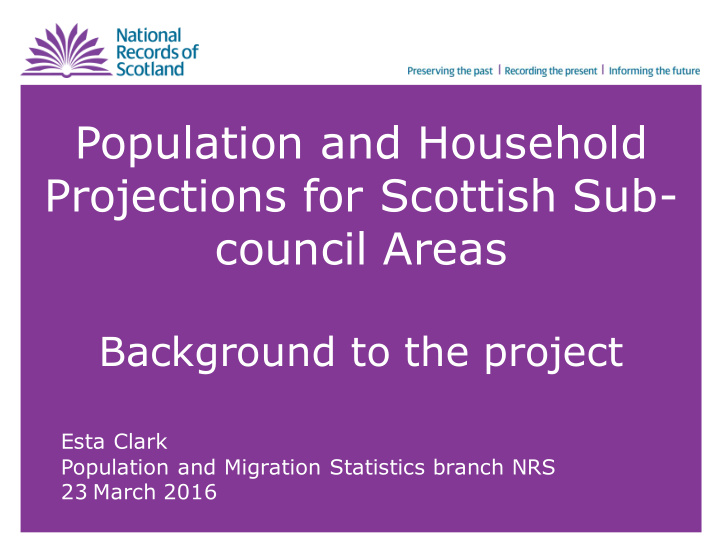



Population and Household Projections for Scottish Sub- council Areas Background to the project Esta Clark Population and Migration Statistics branch NRS 23 March 2016
Agenda for the afternoon 12:45 – Welcome, housekeeping and background: Esta Clark 12:55 – Population projections: Angela Adams 13:25 – Household projections: Esther Roughsedge 13:35 – Questions and discussion 13:50 – Tea and coffee 14:05 – CPC Seminar: Professor Ludi Simpson 14:40 – Questions and discussion 15:00 – Finish
What I will cover • Before we start, an update on 2014-based projection plans • Demand and potential uses identified by councils at the start of the project • Funding and project team • Limitations of projections • Working with councils • Benefits and insights • Uses and feedback
2014-based projections update • 2014-based National Population Projections published 29 October 2015 • Currently testing our new SAS system for Council, NHS Board, National Park and SDP Area population projections • Paper on impact of changes compared with published 2012-based projections ~April • Consultation on migration assumptions ~May • Currently aiming for a June 2016 publication date for 2014-based population projections and October for household projections (dates depend on how well testing goes)
Demand from councils and local planning groups Identified through various routes: • Improvement service for local and community planning • Population and Migration Statistics Committee • Discussed at various other forums e.g. Local Area Research and Intelligence Association (LARIA), SG Centre for Housing Market Analysis (CHMA) etc
Funding and project team • Funded by the Scottish Project team Government Data • Angela Adams, Development Fund Secondee from • One-off project Clydeplan Strategic Development Planning • Looking for feedback Authority • Future work would need • Professor Ludi Simpson to be set alongside other University of Manchester NRS priorities • William Howes • Aim to develop methods • Gail Sinclair • Experimental statistics – data being developed • Hannah Rutherford • Esther Roughsedge • Esta Clark
Potential uses identified by councils at the start of the project – housing need and demand assessment preparation, and to inform local development plans & housing land allocations – identifying care needs , e.g. future elderly care home provision – planning of services for different areas within the council – changes in the age/sex structure of the population and likely consequences for service demand – forecasting the incidence/prevalence of long-term health conditions. This can feed into joint work with the NHS Boards being undertaken to inform the health and social care strategic needs assessment and joint commissioning process
Limitations of projections • Projections are calculations showing what happens under certain assumptions about future fertility, mortality, migration and household formation. • They do not take account of any future changes that may occur as a result of policy initiatives, social or economic change. • They will reflect past policy changes and trends in house building, but they do not incorporate information on planned future policy changes or house building. • These projections are not, therefore, forecasts of what the government expects to happen. • Small areas show more short-term change than larger areas and in the projections, these trends are continued for the length of the projection. • As the process of change is cumulative, the reliability of projections decreases over time.
Working with councils • Sub-Council Area Projections group • consultation on geography in June and July 2015 • pre-release access to quality assure the results in February 2016 • Some councils pre-release access to the draft report in March 2016 • Councils who wanted it were given 3 days pre- release access to the final report to allow them to prepare briefing for informed comment at the time of release
Benefits and insights • We learnt a lot about different population projection methods • A lot about the quality of small area data • Particularly areas with special populations • Strengthened relationships with council contacts, working together
Uses and feedback • We really want to hear from people who use these projections • Are they useful? If so, examples of where you have used them • Feedback on the results and method used • We will be sending a short survey out in about 6 months time • We are happy to come and speak to people about the projections • Once you get a chance to use them we would really like to hear from you
Contact details for feedback: statisticscustomerservices @nrscotland.gov.uk
Recommend
More recommend